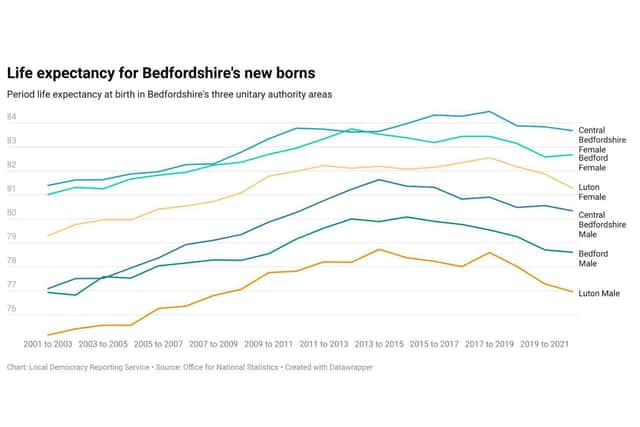Life expectancy in Bedford falls, according to new statistics
and live on Freeview channel 276
New data from the Office for National Statistics has shown a Bedford resident born in 2020/22 isn’t predicted to live as long as someone born in 2012/14.
But the borough council said the average lifespan of babies is determined by changes in mortality rates across their lifetime – and if they improve in the future then “period life expectancy will go back up”.
Advertisement
Hide AdAdvertisement
Hide AdThe Office for National Statistics (ONS) data predicts that a boy in Bedford borough born between 2020 and 2022 will live to 78.6 years.


This is a decrease of 72 weeks when compared with those born between 2012 and 2014 (79.99).
For girls, the expectancy for the same period is 82.67 years, having fallen by 56 weeks when compared with 2012 and 2014.
A Bedford Borough Council spokesperson said: “[Life expectancy] estimates have decreased from peaks seen 10 years ago and have returned to levels last seen around 2010.
Advertisement
Hide AdAdvertisement
Hide Ad“These changes reflect the national trend of stalled improvement in life expectancy over the last decade, and increased mortality during the COVID-19 pandemic, which impacted on life expectancy estimates for 2020 to 2022.


“It is important to note that these are estimates of period life expectancy – i.e. the life expectancy of people at birth if they were to experience mortality rates seen during 2020-22 for the rest of their lives.
“Therefore, the recent fall in life expectancy does not mean that a baby born in 2020-22 will go on to live a shorter life than a baby born a few years earlier; average lifespan of babies born in 2020-22 will be determined by changes in mortality rates across their lifetime.
“If mortality rates improve in the future, then period life expectancy will go back up,” they said.
Advertisement
Hide AdAdvertisement
Hide AdThe council said its new Joint Local Health and Wellbeing Strategy 2024-2027 aims to reduce the differences in health and wellbeing across borough communities and reduce preventable deaths by improving the living conditions and life chances for our residents.
“And improving the health and wellbeing of the most disadvantaged the fastest,” they said.
“Working with our partners in the NHS, the wider public and voluntary sectors and communities themselves we are focusing on five important ‘building blocks’ of health:
- Giving every child the best start in life
- Promoting inclusive employment, lifelong education and workplace health
- Ensuring that we have strong, supportive communities
- Promoting healthy homes, including tackling fuel poverty
- Ensuring that we have sustainable built and natural environment that promotes health and wellbeing
“We are also working closely with our colleagues in the NHS and the voluntary sector to improve access to primary care, increase the number of people being treated for high blood pressure, increase the affordability and availability of healthy food in our communities, and improve the uptake of free school meals for eligible pupils,” they said.
Advertisement
Hide AdAdvertisement
Hide AdThe predicted life expectancy for Central Bedfordshire newborns is higher than that for borough residents.
The average life expectancy for a Central Bedfordshire boy born in 2020-22 is predicted to be nearly one and three-quarter years longer – and a Central Beds girl is predicted to live just over a year longer.
The Bedford council spokesperson continued: “Life expectancy is affected by many factors, such as access to and use of health services; health-related behaviours such as smoking and diet; and wider socioeconomic factors such as education, housing and employment.
“There is therefore no single reason that explains why life expectancy is higher in Central Bedfordshire than in Bedford borough.
Advertisement
Hide AdAdvertisement
Hide Ad“Life expectancy is associated with the overall level of deprivation in an area, with people in more deprived areas dying earlier than their peers in more affluent areas.
“Compared to Central Bedfordshire, Bedford borough is relatively more deprived, ranking 97th out of 151 upper tier and unitary authorities in England (where 1 is the most deprived and 151 is the least), whereas Central Bedfordshire ranks 138th.
“Data for Bedfordshire, Luton, and Milton Keynes (BLMK) as a whole show that two-thirds of the gap in life expectancy between the most and least deprived areas is caused by higher death rates from heart disease and stroke, respiratory disease, and cancers among the most deprived groups.
“In Bedford Borough, the death rate from preventable causes is higher than in Central Bedfordshire,” they said.
Advertisement
Hide AdAdvertisement
Hide AdInformation on health and wellbeing in Bedford borough can be found on the council’s website – www.bedford.gov.uk/social-care-and-health.
A spokesperson for the BLMK Integrated Care Board (ICB) said: “Life expectancy is impacted by a wide variety of things, including inherited conditions, levels of deprivation, local environment including air quality, schooling, being in meaningful work, stable positive relationships, access to green spaces, access to high quality health care.
“Across BLMK various services including local authorities, the NHS, VCSE groups and others work collaboratively to support people towards healthier lifestyles.
“Programmes include smoking cessation, healthy eating and weight management, and many of these also now benefit from apps to help people monitor their progress at their own speed.
“There are also screening programmes for cancers and other conditions; blood pressure monitoring is now available in many pharmacies.”